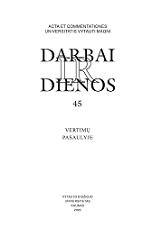Pradžia į begalybę. Mašininis vertimas ir lietuvių kalba
Openning to infinity. Machine Translation and Lithuanian Language
Author(s): Vidas DaudaravičiusSubject(s): Language and Literature Studies
Published by: Vytauto Didžiojo Universitetas
Keywords: Opening; infinity; Machine; Translation; Lithuanian; Language;
Summary/Abstract: The article dwells on the most important landmarks in the history of machine translation (MT). In the middle of the twentieth century, at the time when discussions about machine translation started, it was thought that after several years every person would have a small device allowing people to communicate in any language. Today the view towards machine translation has become more pragmatic. For example, everyone agrees that machine translation of fiction will never be of satisfactory quality. The article discusses three key methods of machine translation, namely, statistical, rulebased, and logical. For practical purposes, often several methods of machine translation areintegrated. In rule-based machine translation the most important role is played by dictionaries and sets of rules. The article demonstrates that morphological, syntactic, and semantic ambiguities are the main obstacles for creating a high quality formal machine translation product. Statistical machine translation is based on data from parallel and monolingual corpora. While statistical machine translation is good for capturing the key words of a sentence, the overall quality of a translation remains low. The limited size of parallel corpora is the main obstacle of statistical machine translation. The article also discusses evaluation criteria for assessing MT quality, which is often very problematic.
Journal: Darbai ir dienos
- Issue Year: 2006
- Issue No: 45
- Page Range: 7-18
- Page Count: 12
- Language: Lithuanian

